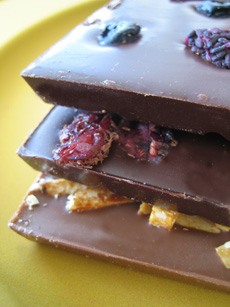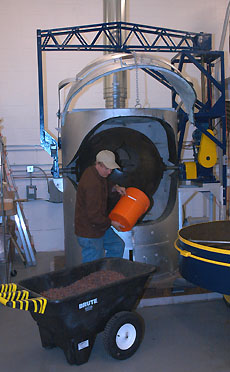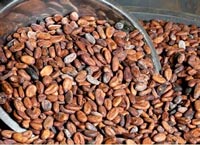 
Artisanal bars from Michael Mischer Chocolates of Oakland, California. Photo by Melody Lan | THE NIBBLE.
|
KAREN HOCHMAN’s first word was not cacahuatl...but as her mother will attest, it was pretty close.
|
|
May 2006
Revised January 2009
|
 |
From Pod to Palate: The Birth Of The Bar
Page 4: Making The Chocolate ~ Roasting The Beans
This is Page 4 of a 10-page article on chocolate production. Click on the black links below to visit other pages.
Making The Chocolate
6. Roasting
 Once the beans are cleaned, they are ready to begin their transformation into chocolate. Next they will be roasted in large, rotating roasting ovens, just like coffee beans. A rotating drum tosses the beans about so they will roast evenly. The producer has the option of roasting them before the shell is removed, or of removing the shell first. In general, chocolate manufacturers prefer to roast the beans before shelling them, while cocoa processors favor roasting the shelled nib; it retains more cocoa butter since cocoa butter can’t migrate from the bean into the shell during the roasting process (chocolate manufacturers can always add in more cocoa butter later in the manufacturing process). Roasting the entire bean in its shell allows for more variety in the degree of roast and development of flavor (i.e., the producer can choose a light roast or a dark roast depending on the desired flavor outcome), but requires beans of a uniform size. Once the beans are cleaned, they are ready to begin their transformation into chocolate. Next they will be roasted in large, rotating roasting ovens, just like coffee beans. A rotating drum tosses the beans about so they will roast evenly. The producer has the option of roasting them before the shell is removed, or of removing the shell first. In general, chocolate manufacturers prefer to roast the beans before shelling them, while cocoa processors favor roasting the shelled nib; it retains more cocoa butter since cocoa butter can’t migrate from the bean into the shell during the roasting process (chocolate manufacturers can always add in more cocoa butter later in the manufacturing process). Roasting the entire bean in its shell allows for more variety in the degree of roast and development of flavor (i.e., the producer can choose a light roast or a dark roast depending on the desired flavor outcome), but requires beans of a uniform size.
Loading beans into the roaster at Amano Artisan Chocolate.
The beans are roasted at a wide range of temperatures and times—we have seen ranges given from less than 200° to 300°F and from 10 minutes to 2 hours, although  this will varies widely based on the producers and the type of beans. Chocolatier Jacques Torres, for example, roasts his beans at 160°F for 30 minutes. The roasting is necessary for the development of the cacao flavor and aroma. It is a very critical process that must be closely monitored. If the beans are roasted at a low temperature and for a brief time, it will preserve the fruitiness of the cacao bean—you’ll notice a red fruit quality in the chocolate flavor. If the beans are treated to a darker roast—higher temperatures and for a longer time—nuttier flavors will develop. It is a preference of the producer, as well as the characteristic of the bean, that dictates the roast. Each type of bean is roasted separately. After the beans are roasted, a machine called a cooler rotates the beans and circulates air to cool the hot roasted beans. this will varies widely based on the producers and the type of beans. Chocolatier Jacques Torres, for example, roasts his beans at 160°F for 30 minutes. The roasting is necessary for the development of the cacao flavor and aroma. It is a very critical process that must be closely monitored. If the beans are roasted at a low temperature and for a brief time, it will preserve the fruitiness of the cacao bean—you’ll notice a red fruit quality in the chocolate flavor. If the beans are treated to a darker roast—higher temperatures and for a longer time—nuttier flavors will develop. It is a preference of the producer, as well as the characteristic of the bean, that dictates the roast. Each type of bean is roasted separately. After the beans are roasted, a machine called a cooler rotates the beans and circulates air to cool the hot roasted beans.
Photo courtesy of Scharffen Berger Chocolate.
Roasting develops the color and is the second stage in the development of the chocolate flavor that began during the fermentation on the estates. It’s food chemistry at its finest: the aroma of roasted cacao is made of a combination of some compounds resulting from fermentation and not involved in roasting, some compounds resulting from fermentation and increased by roasting, and some new compounds which are developed during roasting.
Continue To Page 5: Winnowing
Go To The Article Index Above

|





 Once the beans are cleaned, they are ready to begin their transformation into chocolate. Next they will be roasted in large, rotating roasting ovens, just like coffee beans. A rotating drum tosses the beans about so they will roast evenly. The producer has the option of roasting them before the shell is removed, or of removing the shell first. In general, chocolate manufacturers prefer to roast the beans before shelling them, while cocoa processors favor roasting the shelled nib; it retains more cocoa butter since cocoa butter can’t migrate from the bean into the shell during the roasting process (chocolate manufacturers can always add in more cocoa butter later in the manufacturing process). Roasting the entire bean in its shell allows for more variety in the degree of roast and development of flavor (i.e., the producer can choose a light roast or a dark roast depending on the desired flavor outcome), but requires beans of a uniform size.
Once the beans are cleaned, they are ready to begin their transformation into chocolate. Next they will be roasted in large, rotating roasting ovens, just like coffee beans. A rotating drum tosses the beans about so they will roast evenly. The producer has the option of roasting them before the shell is removed, or of removing the shell first. In general, chocolate manufacturers prefer to roast the beans before shelling them, while cocoa processors favor roasting the shelled nib; it retains more cocoa butter since cocoa butter can’t migrate from the bean into the shell during the roasting process (chocolate manufacturers can always add in more cocoa butter later in the manufacturing process). Roasting the entire bean in its shell allows for more variety in the degree of roast and development of flavor (i.e., the producer can choose a light roast or a dark roast depending on the desired flavor outcome), but requires beans of a uniform size.  this will varies widely based on the producers and the type of beans. Chocolatier Jacques Torres, for example, roasts his beans at 160°F for 30 minutes. The roasting is necessary for the development of the cacao flavor and aroma. It is a very critical process that must be closely monitored. If the beans are roasted at a low temperature and for a brief time, it will preserve the fruitiness of the cacao bean—you’ll notice a red fruit quality in the chocolate flavor. If the beans are treated to a darker roast—higher temperatures and for a longer time—nuttier flavors will develop. It is a preference of the producer, as well as the characteristic of the bean, that dictates the roast. Each type of bean is roasted separately. After the beans are roasted, a machine called a cooler rotates the beans and circulates air to cool the hot roasted beans.
this will varies widely based on the producers and the type of beans. Chocolatier Jacques Torres, for example, roasts his beans at 160°F for 30 minutes. The roasting is necessary for the development of the cacao flavor and aroma. It is a very critical process that must be closely monitored. If the beans are roasted at a low temperature and for a brief time, it will preserve the fruitiness of the cacao bean—you’ll notice a red fruit quality in the chocolate flavor. If the beans are treated to a darker roast—higher temperatures and for a longer time—nuttier flavors will develop. It is a preference of the producer, as well as the characteristic of the bean, that dictates the roast. Each type of bean is roasted separately. After the beans are roasted, a machine called a cooler rotates the beans and circulates air to cool the hot roasted beans.